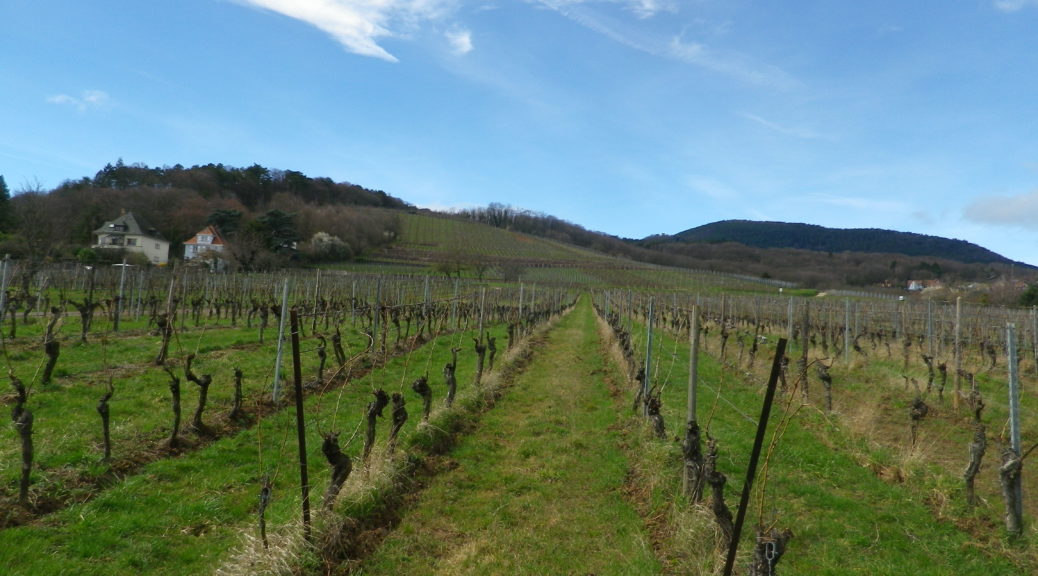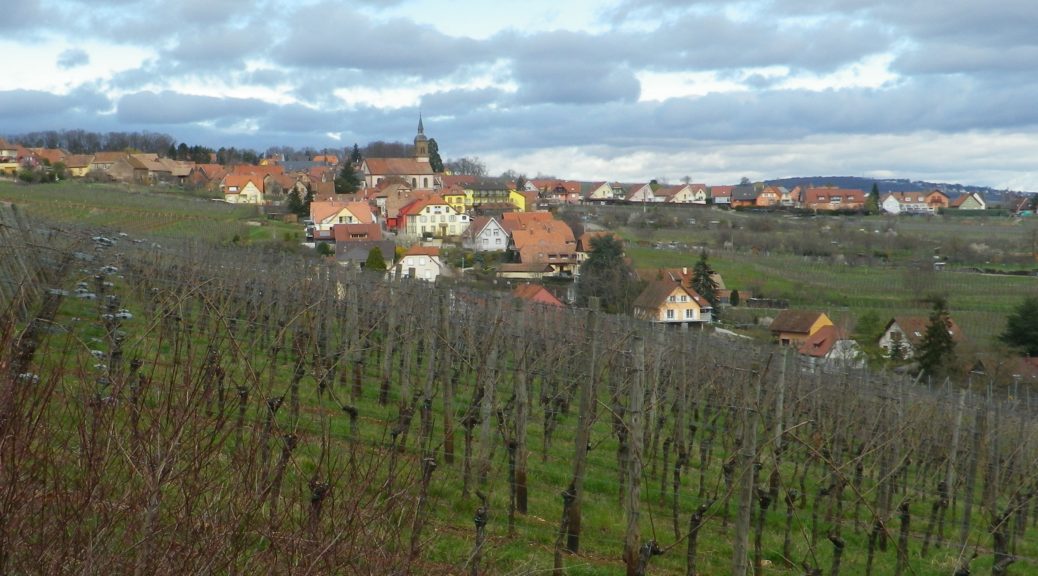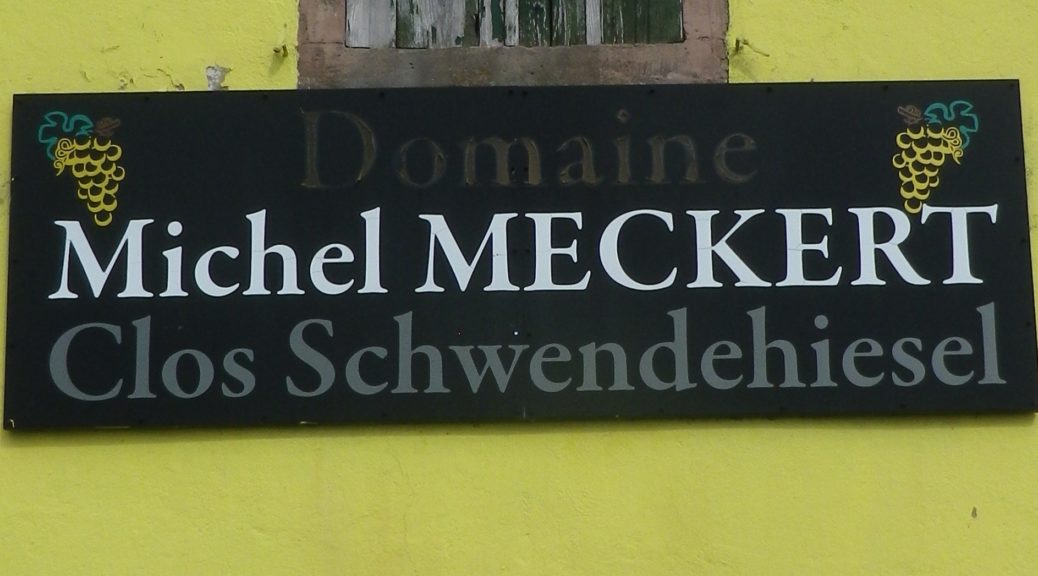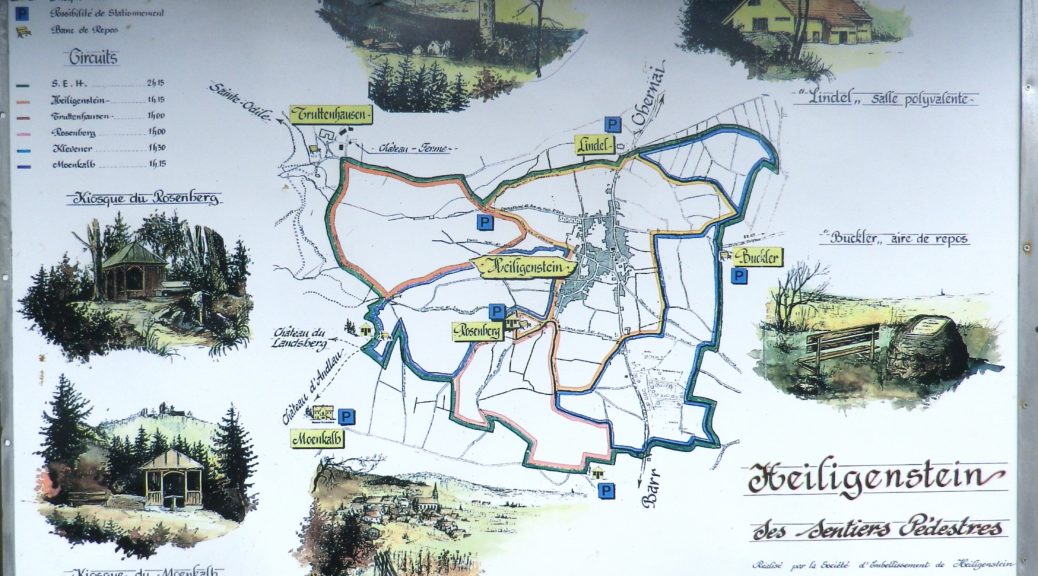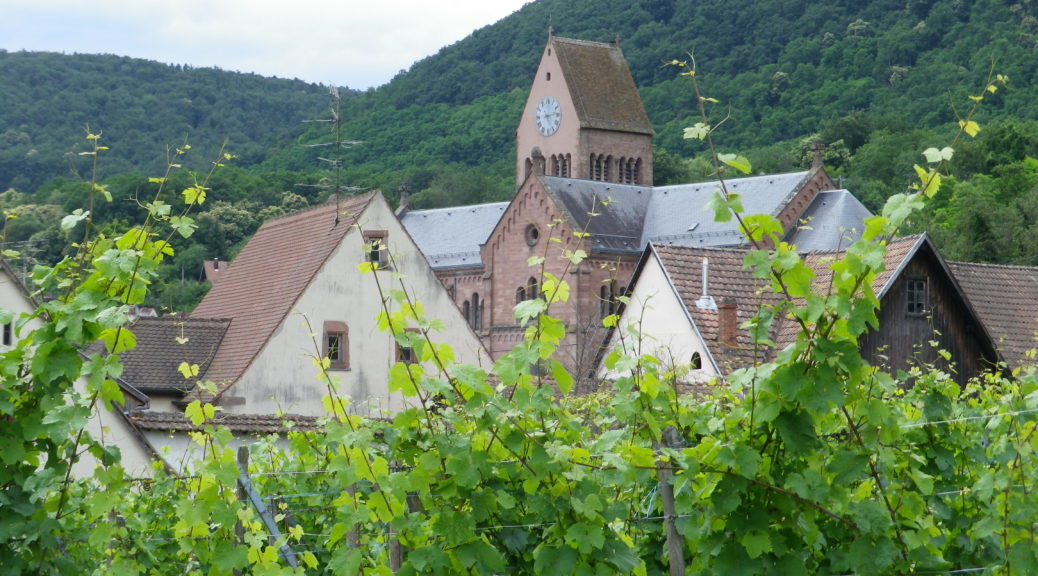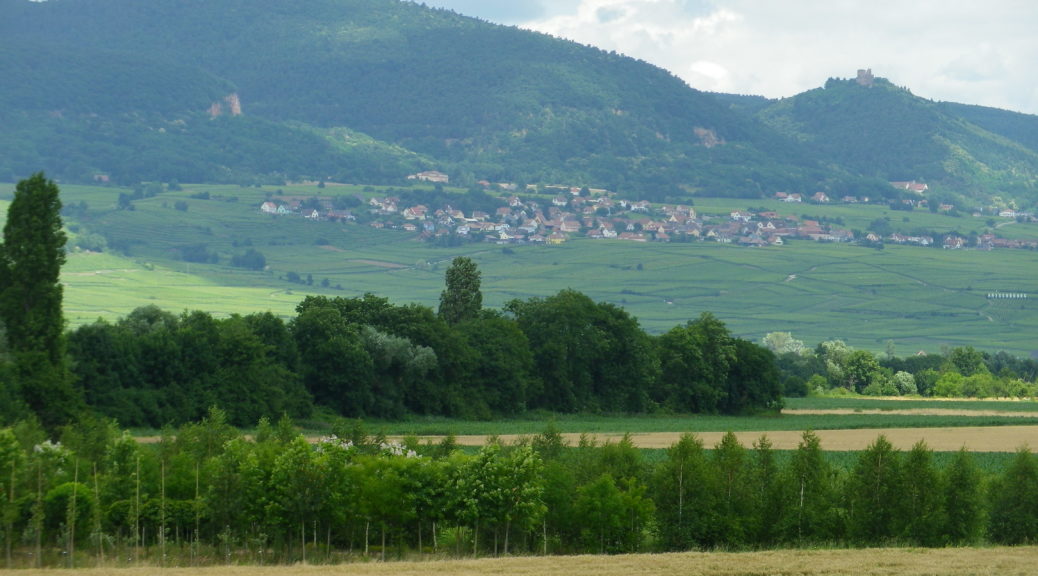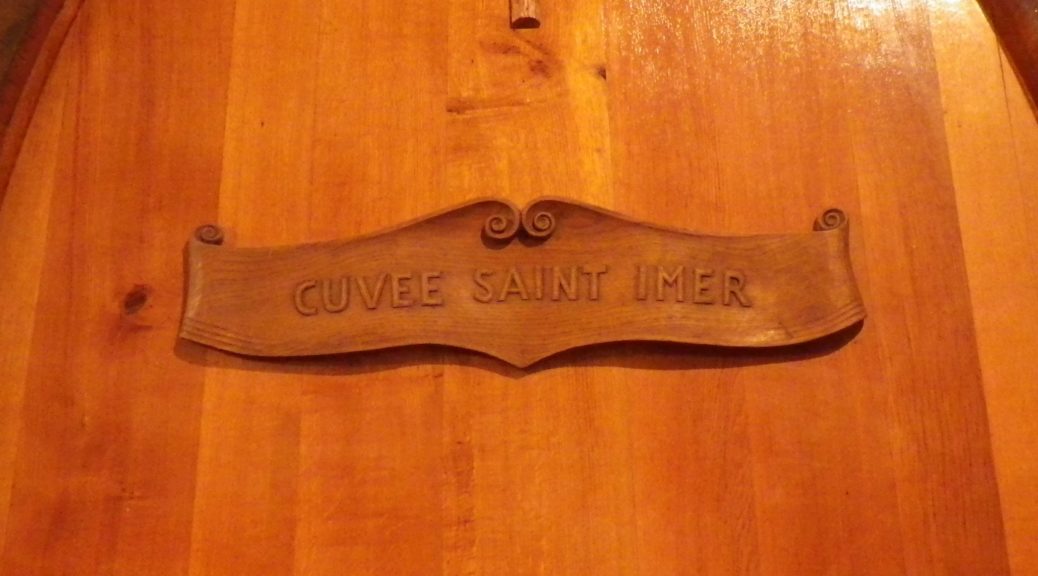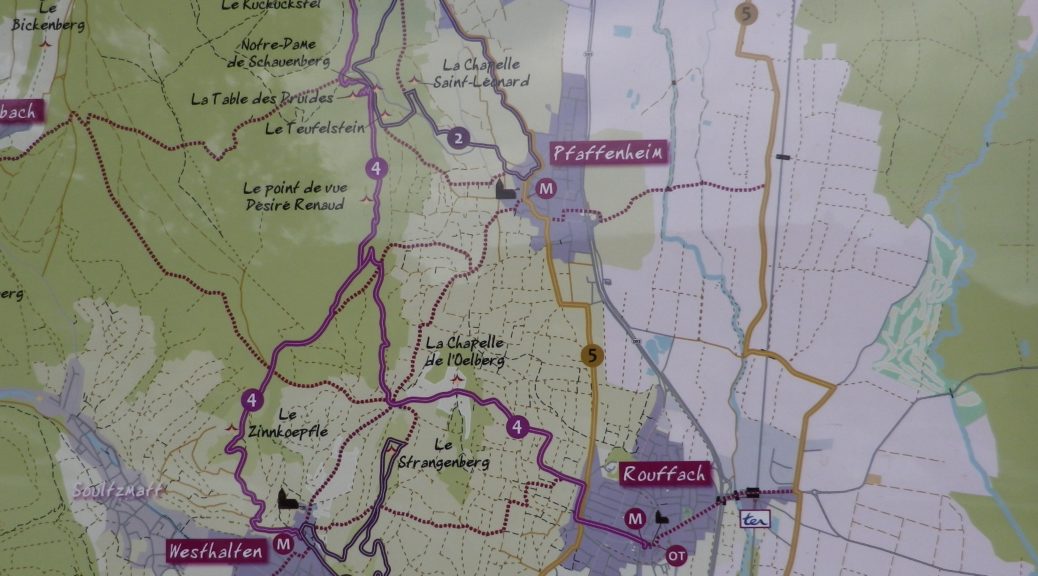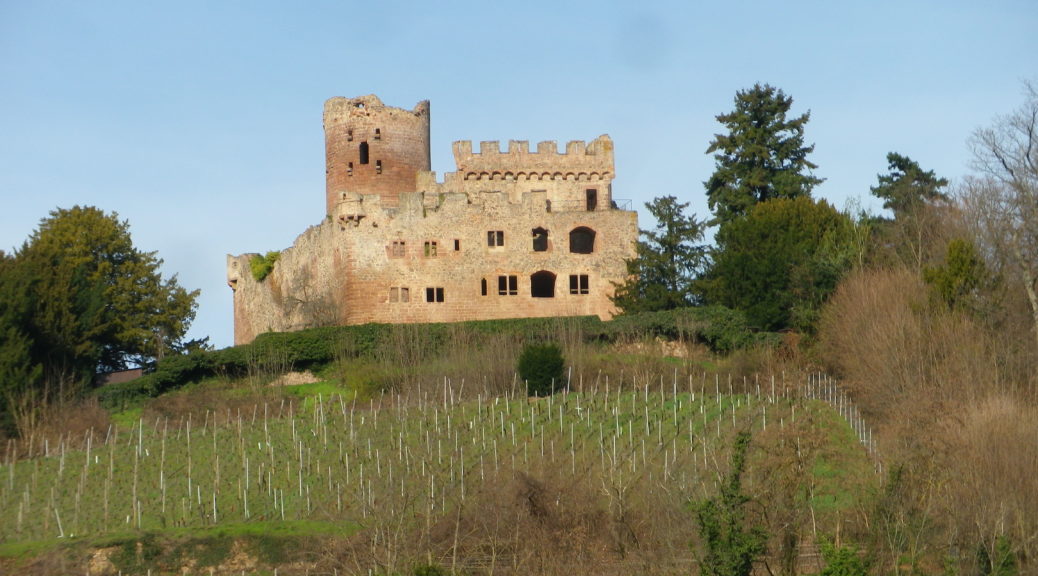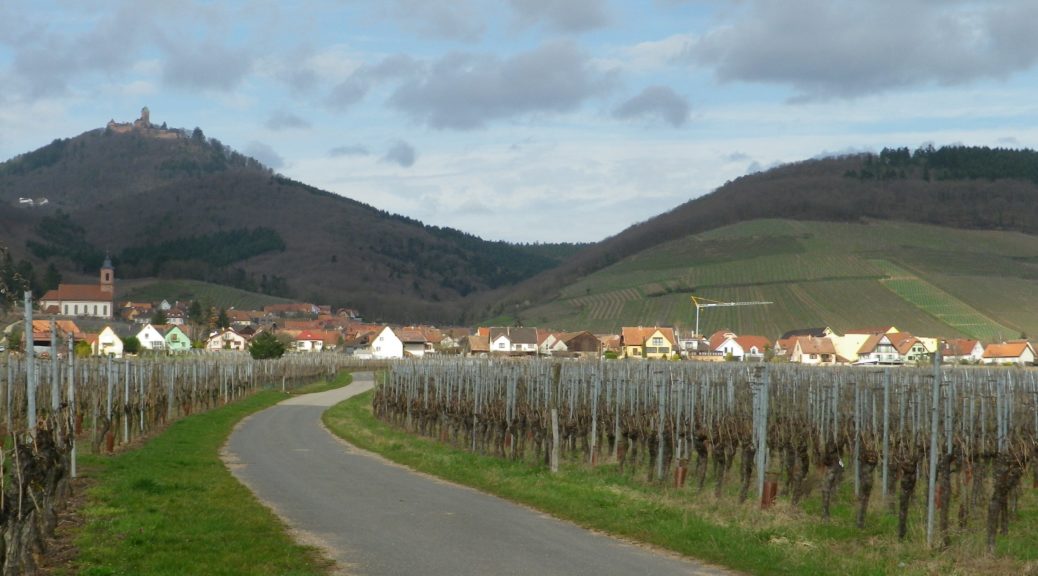Tag Archives: France/Alsace
Uniquely Special in Alsace
There’s the Abbey of Truttenhausen, the Roseraie (Rose Garden), the Bear Fountain, and the famous (-for what, I don’t know-) Linden tree. All count among Heiligenstein’s attractions. I, however, was attracted to the grape vines. In Heiligenstein (and neighboring villages), the grape is the Savagnin rose, unique in Alsace. Heiligenstein’s vintners produce a special wine from this grape known as Klevener de Heiligenstein, a special aromatic wine reminiscent of Gewuerztraminer.
Fortunately, Heiligenstein has a number of hiking itineraries (and cycling itineraries) that pass through its vineyards. I selected one, a circuit, and computed the time I needed to finish before the wineries closed and the winter sun set behind the mountains. Mount Saint Odile lies to the west of the village. While only half the height of the tallest peak in the Vosges range, it rises sufficiently abruptly from the small town to form a protective barrier from the wind and cold.
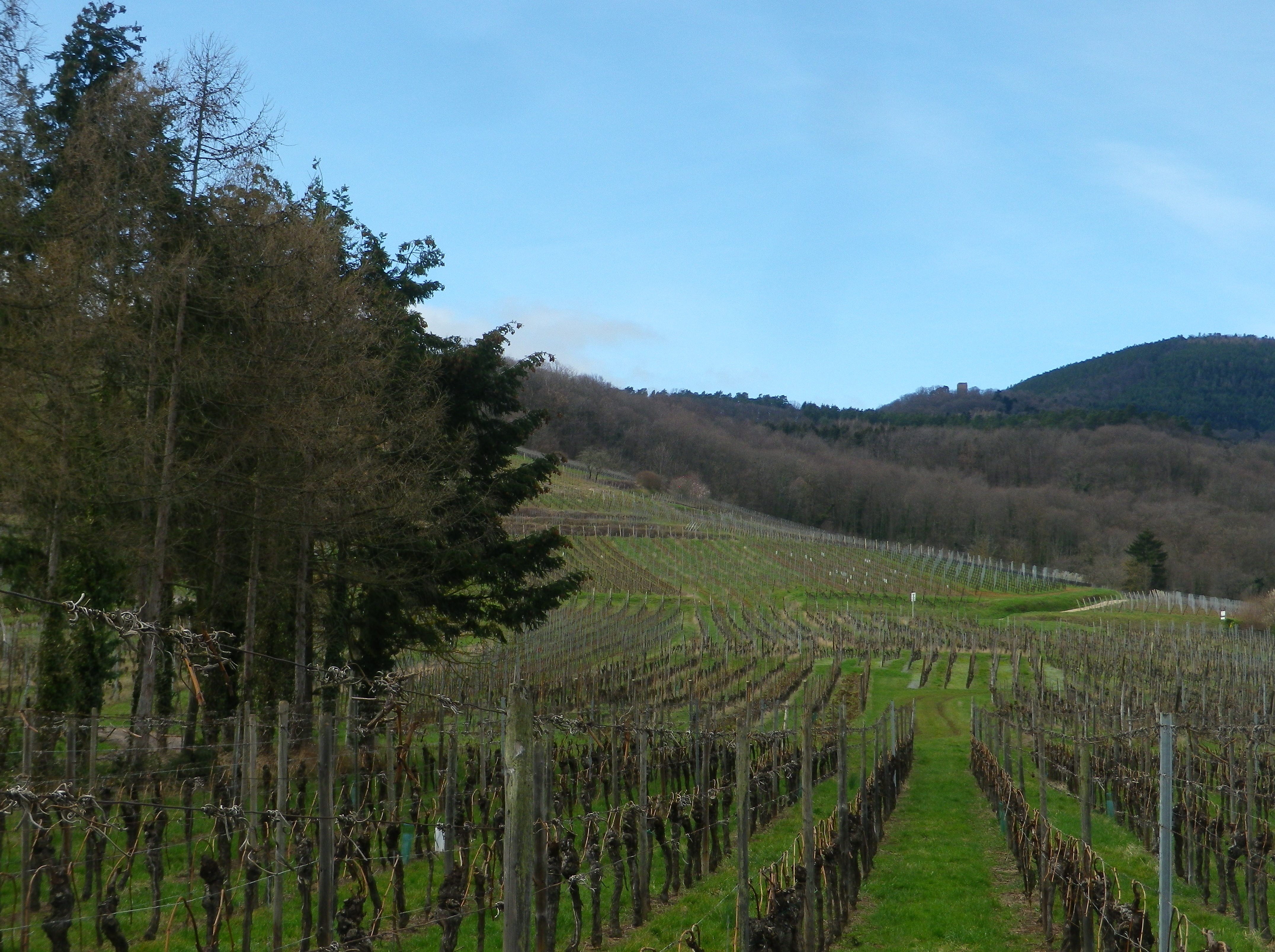
Thus, on a late February afternoon, the trail conditions were snow and ice free, even if it had been a bit rainy. No games or practices that day (maybe rain delays?), so the parking lot at the sports field was empty. Thus, it was a quiet start heading toward the mountain, but not a gloomy one. Rays of sun occasionally poked out from behind the clouds. Bright green was everywhere, even in winter, watered by the springs and rivulets that bubbled and burbled from the mountain side.
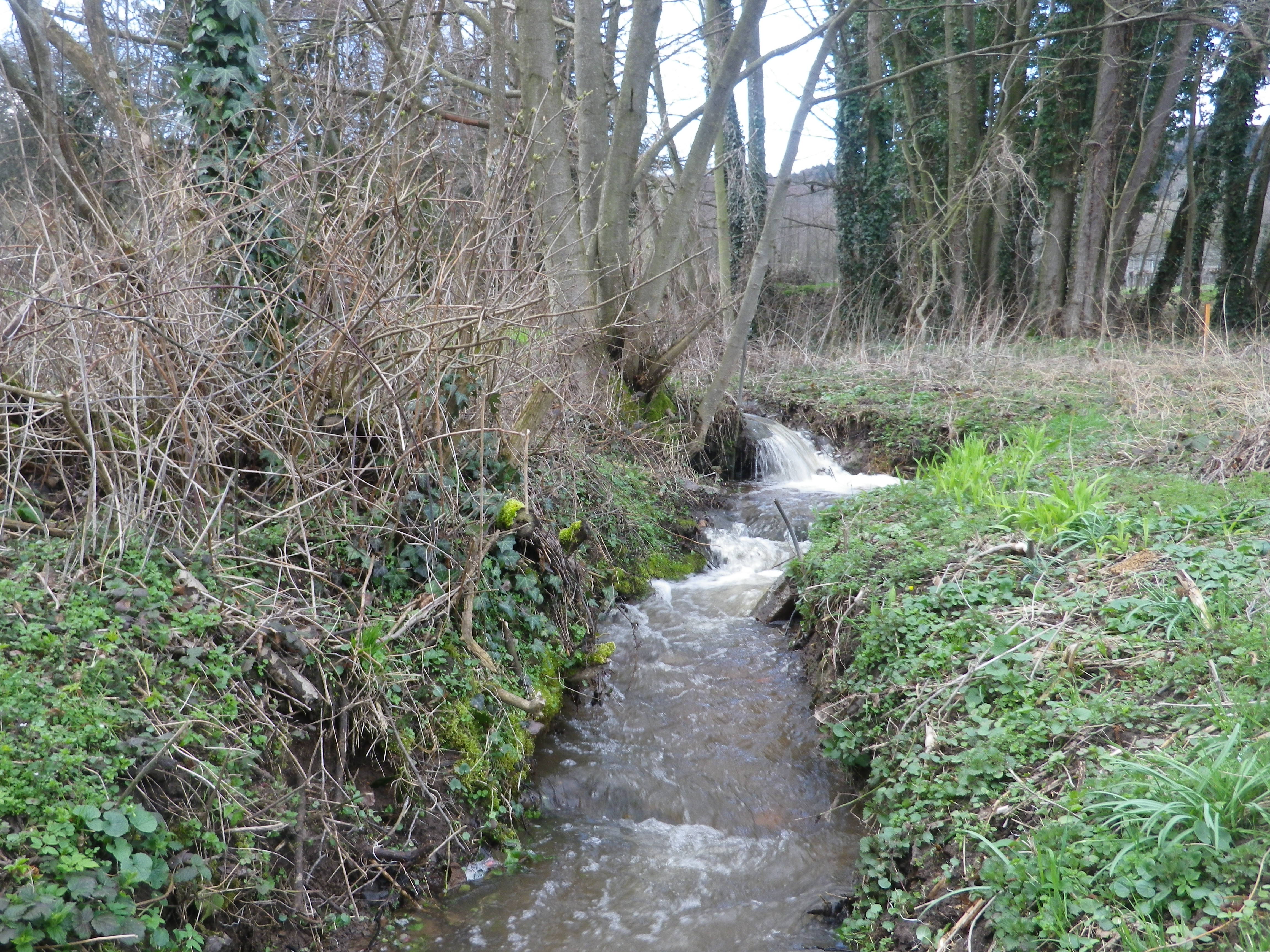
Approaching the area of Truttenhausen, signs to the Abbey appeared. Now in ruins, it is one of a couple of abbeys or chapels that developed on the slopes of Mount Saint Odile, a special place for a special saint from Alsace – one of their own who lived in this area about 1400 years ago. Her massive convent atop the mountain, with a statue of the saint high above it, casts a protective eye over much of northern Alsace. (Worth a visit for the 360 degree views.) While my trail was significantly lower down the slope, the views across the Rhine River valley over to Germany were still awesome nonetheless.
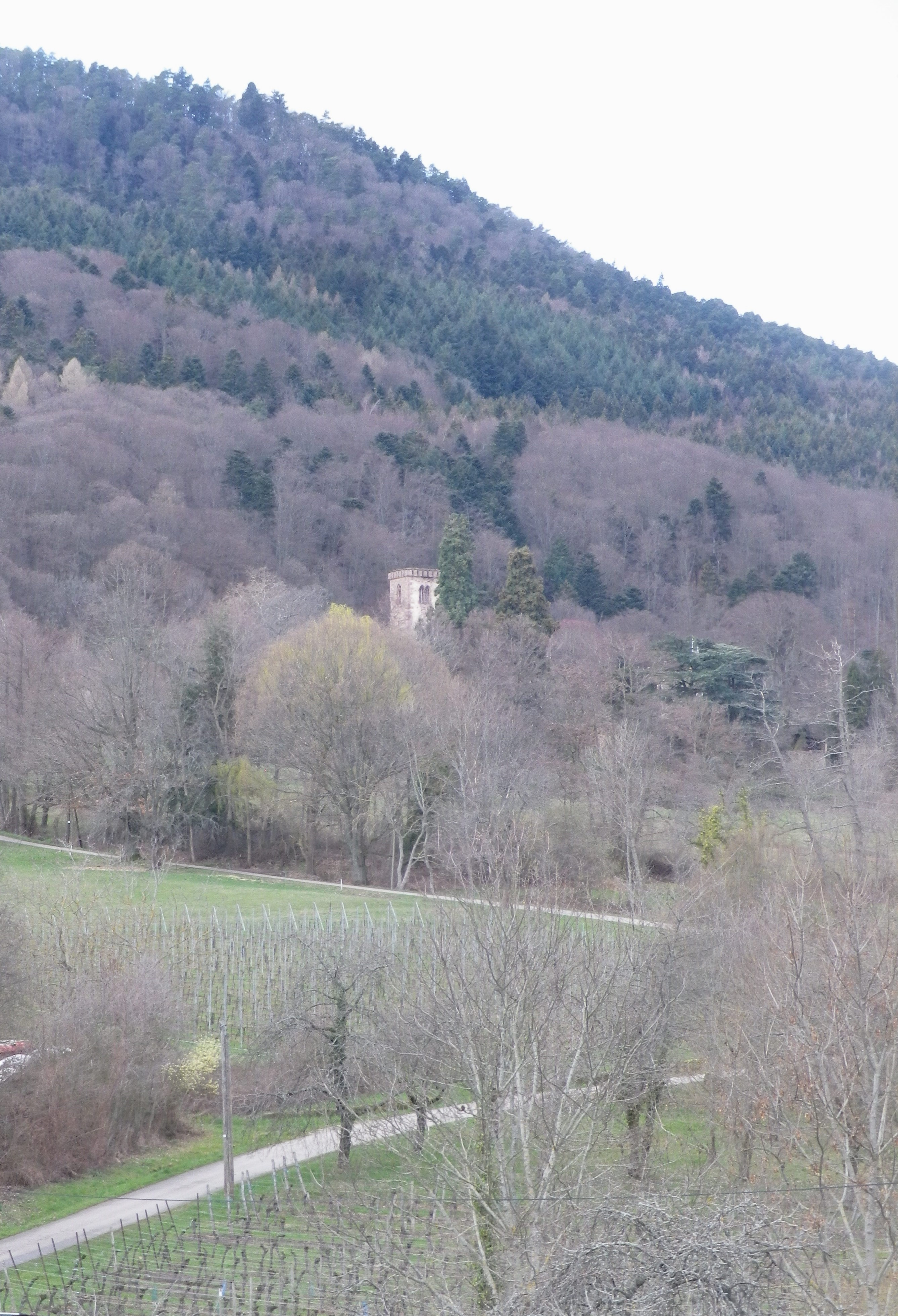
It wasn’t until after passing the famous landmark of the Linden of Heiligenstein, that the true extent of the town’s vineyards revealed itself. For beneath the tree-covered slopes of Mount Sainte Odile, vineyards extend downhill, toward the east and southeast for an impressive distance, until they adjoin the grain and vegetable fields of flatter lands to the east.
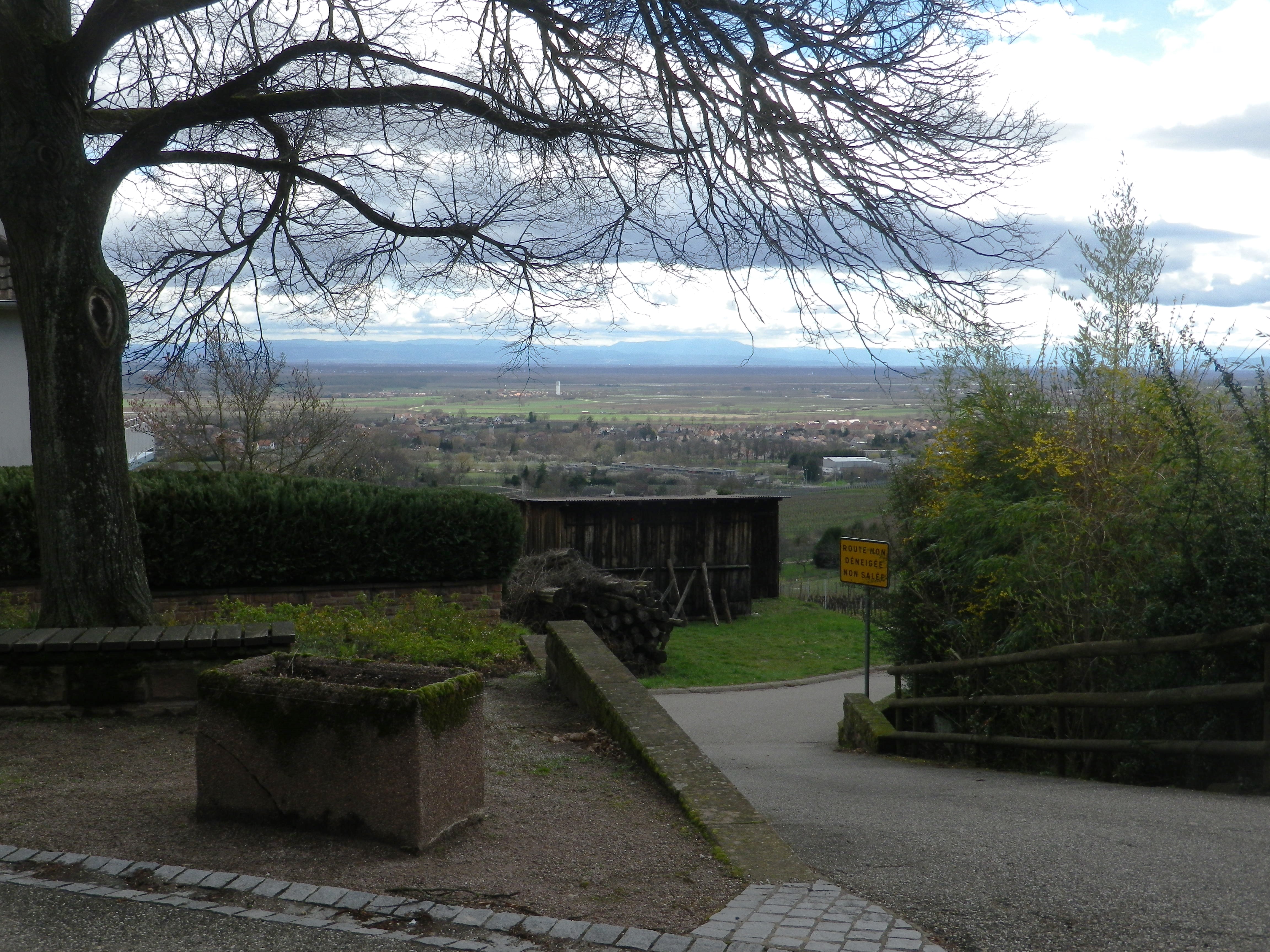
Following the circuit below the town placed me amidst acres of vines. Many plots have names, often they are (or were) enclosed. Many of the clos of Alsace are famous. One here was partially enclosed, but it never was famous, although it was obviously beloved by the local vintners at one point. Clos are special places where the grapes are particularly valued, hence protected by walls. Who knows – perhaps this is the plot where the grapes for the wine destined for the Bishop of Strasbourg, only 20 kilometers (about 12 miles) distant, grew. (Several towns, on both sides of the Rhine, owed an annual amount of wine to the Bishop of Strasbourg. Heiligenstein was just one of them.)
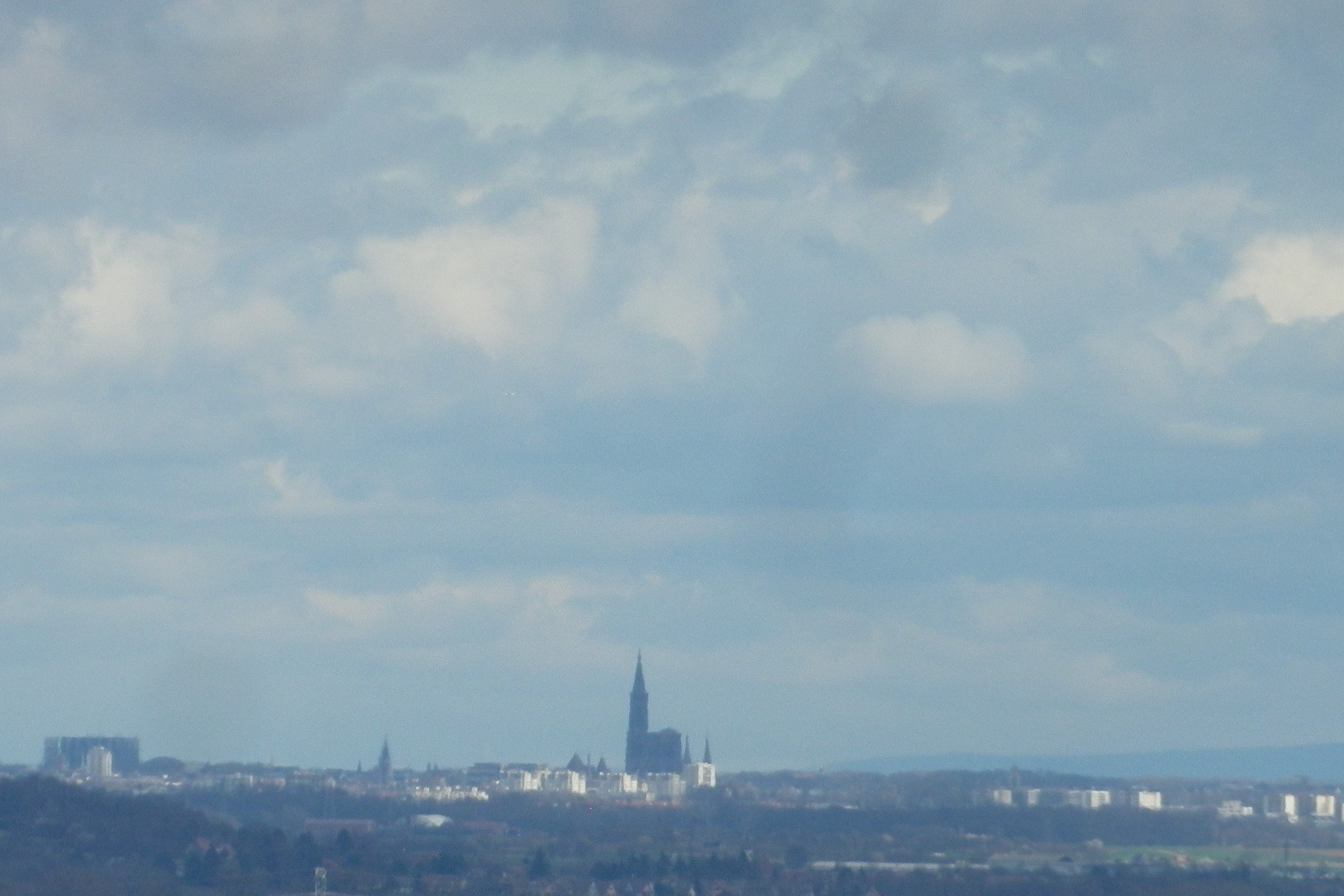
At the end of the circuit, I was less than half a kilometer from a few family-owned wineries. But it was necessary to jog to them to ensure I arrived before closing time. Unfortunately, there never seems to be enough time to enjoy wine! And unique wines like Klevener de Heiligenstein need both time and a special, objective perspective to savor them.
Wine Notes: Klevener de Heiligenstein
What I Learned
In 1742, Ehrhardt Wantz, mayor of the small village of Heiligenstein in Alsace, brought some Savagnin Rose vines from Italy. Descended from the Traminer grape (Gewuerztraminer), which also came originally from Italy, these grapes were planted in Heiligenstein and subsequently in some surrounding villages (Gertwiller, among them). Currently a dozen or so vintners work with this varietal. Supplanted then as now in many respects by the Gewuerztraminer, it has a subtler aroma and flavor profile, and is less well-known. It finally obtained Appellation Alsace Klevener d’Heiligenstein Controlee status in 1971. (Reference: Alsace Habsiger Domaine website: https://www.domaine-habsiger.fr/#klevener)
Heiligenstein does not have any Grands Crus, although it does have some well-sited vineyards, favored with good slope and sun and wind exposure, along with vintners passionate about creating their wines. Subtle, yet aromatic, the unique Klevener de Heiligenstein wine truly deserves its appellation status.
What I Tasted
2017 Klevener de Heiligenstein (Savagnin), Cuvee Numero 1, Appellation d’Alsace Controlee, Domaine Charles Boch (Heiligenstein): A dry white wine with medium yellow gold color; a floral and pear nose, with strong floral and mineral flavors, with a hint of green fruit, medium minus acidity.
2017 Klevener de Heiligenstein (Savagnin), Cuvee Tentation, Appellation d’Alsace Controlee, Domaine Charles Boch (Heiligenstein): A dry white wine with pale, white gold color; floral and spice nose, with honey, spice, toasted nuts and floral flavors; medium minus acidity.
2016 Klevener de Heiligenstein (Savagnin), Appellation d’Alsace Controlee, Kleinbuhr: A dry white wine with medium plus yellow gold color; a floral nose with hints of turpentine (as in reminiscent of Riesling); spice, floral (rose) and nutty flavors; medium plus acidity, with a smooth finish.
2016 Klevener d’Heiligenstein (Savagnin), Appellation d’Alsace Controlee, Maison Alsace Habsiger (Gertwiller): A dry white wine with medium gold color; slight floral nose, with honey, floral, mineral and very slight exotic fruits flavors; medium acidity.
Klevener de Heiligenstein: Trail in a Nutshell
Trail Name: Klevener de Heiligenstein
Trail Type: A short distance circuit; well-maintained and much of it paved or hard-pack, marking on the trail varies.
Length:
Total – 7.5 kilometers/ 4.7 miles
Convenient to: Barr, Alsace, France
Marking:
Varied, and none specific to the circuit
Trail Description: A delightful short trail, easily done, which covered vineyards and town, and gave distant views of the Black Forest in Germany and Alsatian landscapes near and far. As it was in a sheltered, and lower position, this itinerary presented no problems in the winter with snow or ice.
Trailhead:
Heiligenstein: Sports field, R. Principale/D35
Parking:
Heiligenstein on the north end of the main road, R. Principale/D35, on the north edge of town, by the Sports Field
Public Transportation Options:
Rail: SNCF Trains from Strasbourg service nearby Gertwiller. From that station, the southern-most point of the trail is about 1 kilometer distant. (The station in Barr is a bit further, but also larger.)
Suggested Stages:
Not applicable
Trail Itinerary-Reference Points: (Counterclockwise)
Heiligenstein: R. Principale/D35, R. (du) Kritt, R. des Chateaux; Truttenhausen: Kiosk and Hering Monument, Chemin du Moenkalb, past the Tilleul du Moenkalb (a famous linden tree); R. du Weinberg; vineyards, than an unimproved path downhill to cross R. Principale/D35; pass north of Domaine Bachert; through vineyards and fields, @100 yds on Saint Simonsbrunnen, go right onto small paved path, follow to T intersection, cross R Ehret Wantz; dogleg left, then first right to follow the winding road for about 400 meters/1250 feet, then rightat the Y intersection; take second left to return to sports field on D35 (see Lookout Point by the Sports Field),
Representative Trail Photos:
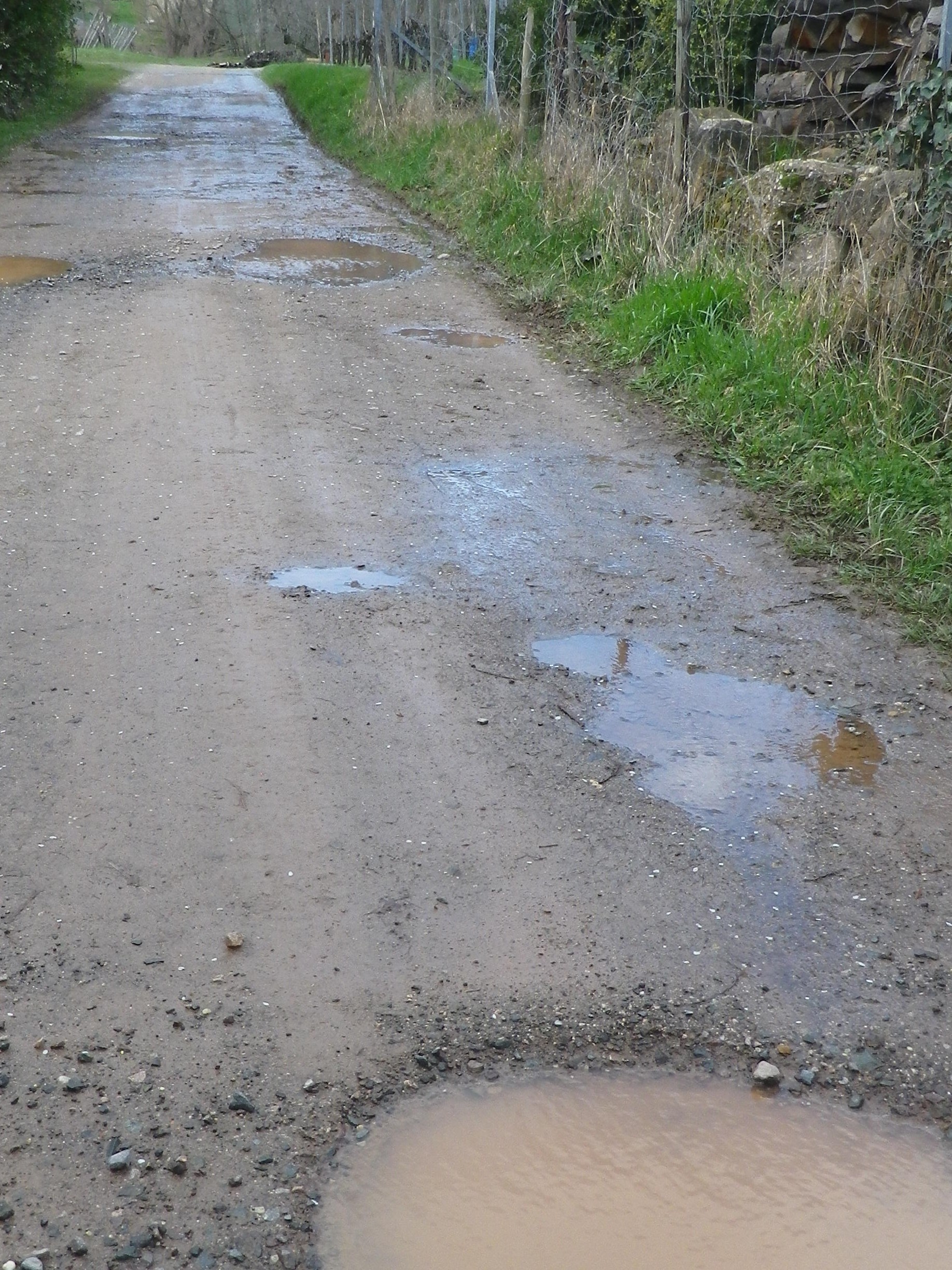
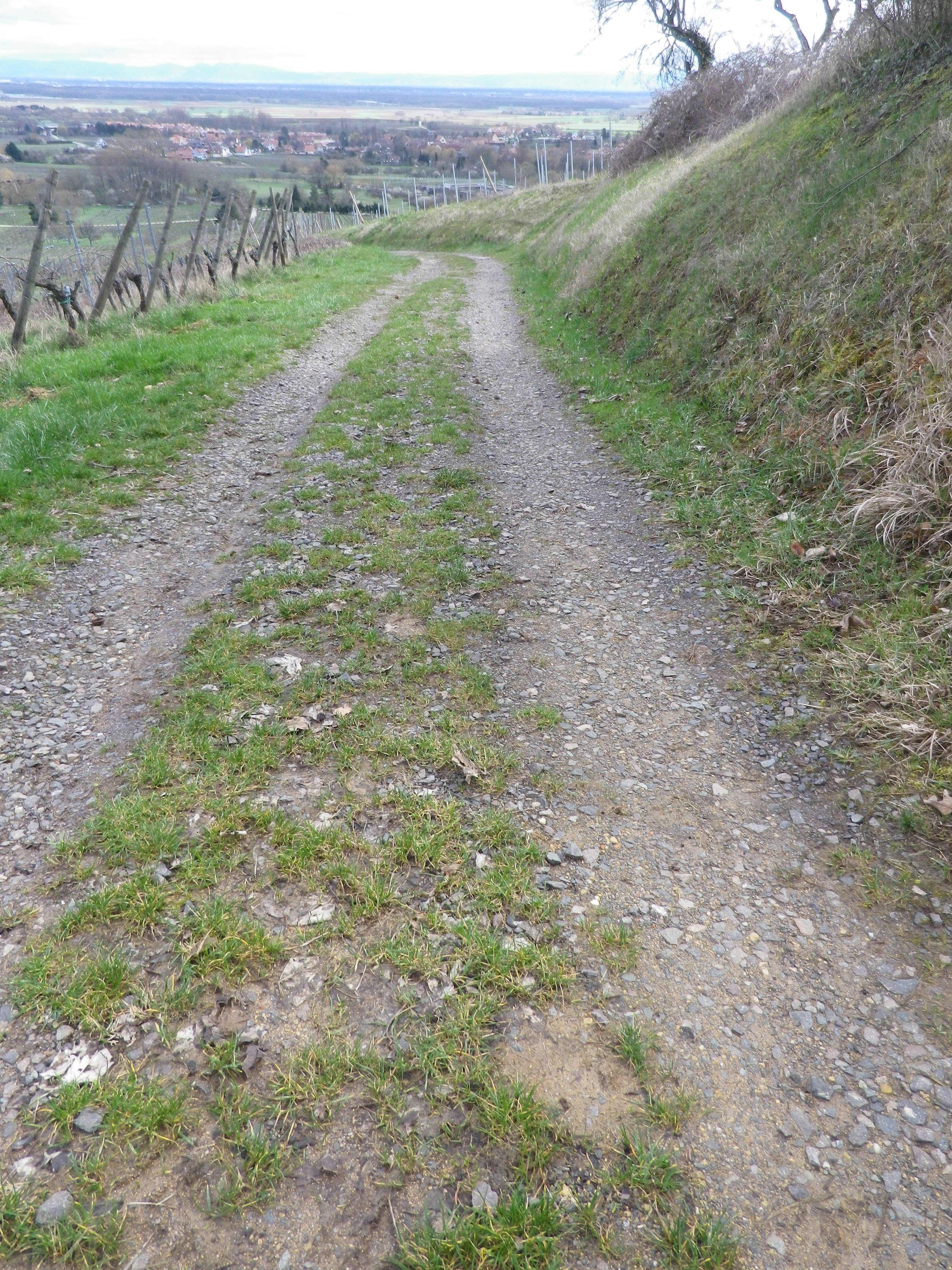
Restrooms:
Heiligenstein: R. Principale, behind the Mairie
Attractions on or near Trail:
None wine-related, other than the wineries!
Tasting along the Trail:
A few wineries on or near the trail that specialize in this varietal, and then other as well nearby.
Alternative Options:
Biking: Klevener et Pain d’Epice, a 32 kilometer/ 20 mile cycling circuit in this region. See https://www.alsaceavelo.fr/403000071-bl214-klevener-et-pain-depices/
Car: Heiligenstein is one of dozens of villages on the Route des Vins D’Alsace, almost 180 kilometers of car-touring route focused on Alsatian wines and through Alsatian vineyards.
Additional Information:
Regional: https://www.visit.alsace/
Trail specific:
https://apps.tourisme-alsace.info/photos/cdcbarr/photos/213000384_d1.pdf
Comments:
A peaceful village, in one of the least travelled sections of the Route des Vins d’Alsace, cultivating a varietal that is unique in France.
Gallery August 2023
Through Crus and Clos
Passing through vineyards in the Haut- Rhin department in Alsace is always delightful, especially when passing through some Grands Crus vineyards. This trail also ran by, not through, other vineyards known as clos. By definition, clos are vineyards enclosed by walls. They are special places, like the Grands Crus, each with a special pedigree, producing sought-after wines.
This circuit trail began in Rouffach, a town I had never visited. I would visit the compact historical center after my ride, tucked away from the modern main roads (D18Bis), wishing I had more time to spend there! Then again, time there would have meant taking time from some of the other equally delightful towns and villages (Hattstatt, Obermorschwihr, Eguisheim, Voegtlinshoffen, Gueberschwihr and Pfaffenheim) along the route.
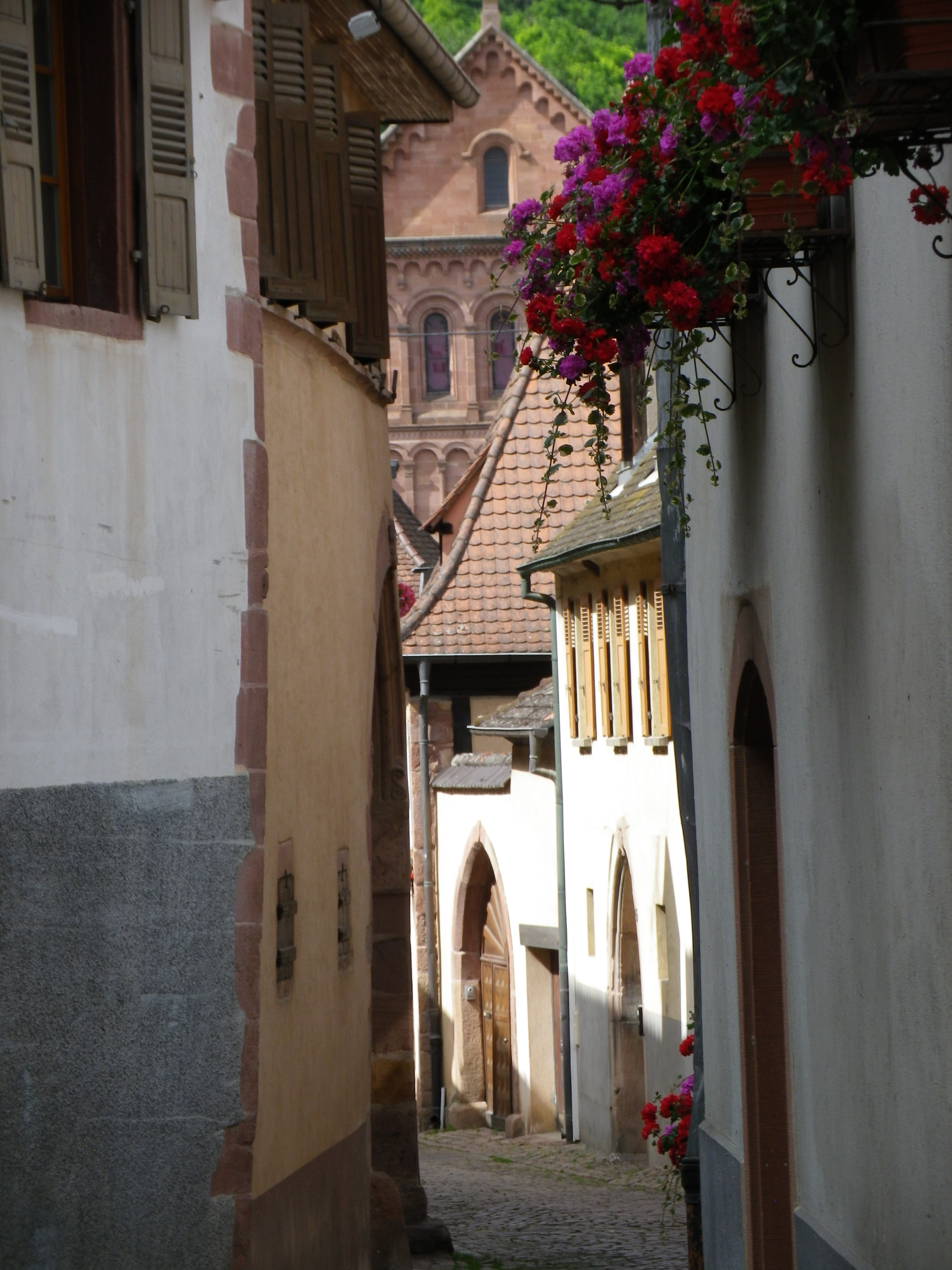
But this circuit was also about the well-respected vineyards in this sector of the Alsace wine region. No sooner through the built-up area of Rouffach, Clos de St Landelin comes into view. Like many clos or Grands Crus, this one also spelled out its name in large letters, another mark of distinction for these special vineyards. Named after an itinerant Irish monk, Clos de St Landelin lies within the Grand Cru of Vorbourg, overlooking Rouffach. I would see this combination of Grand Cru and Clos again, further north, where the Goldert Grand Cru has the Clos de St Imer within it.
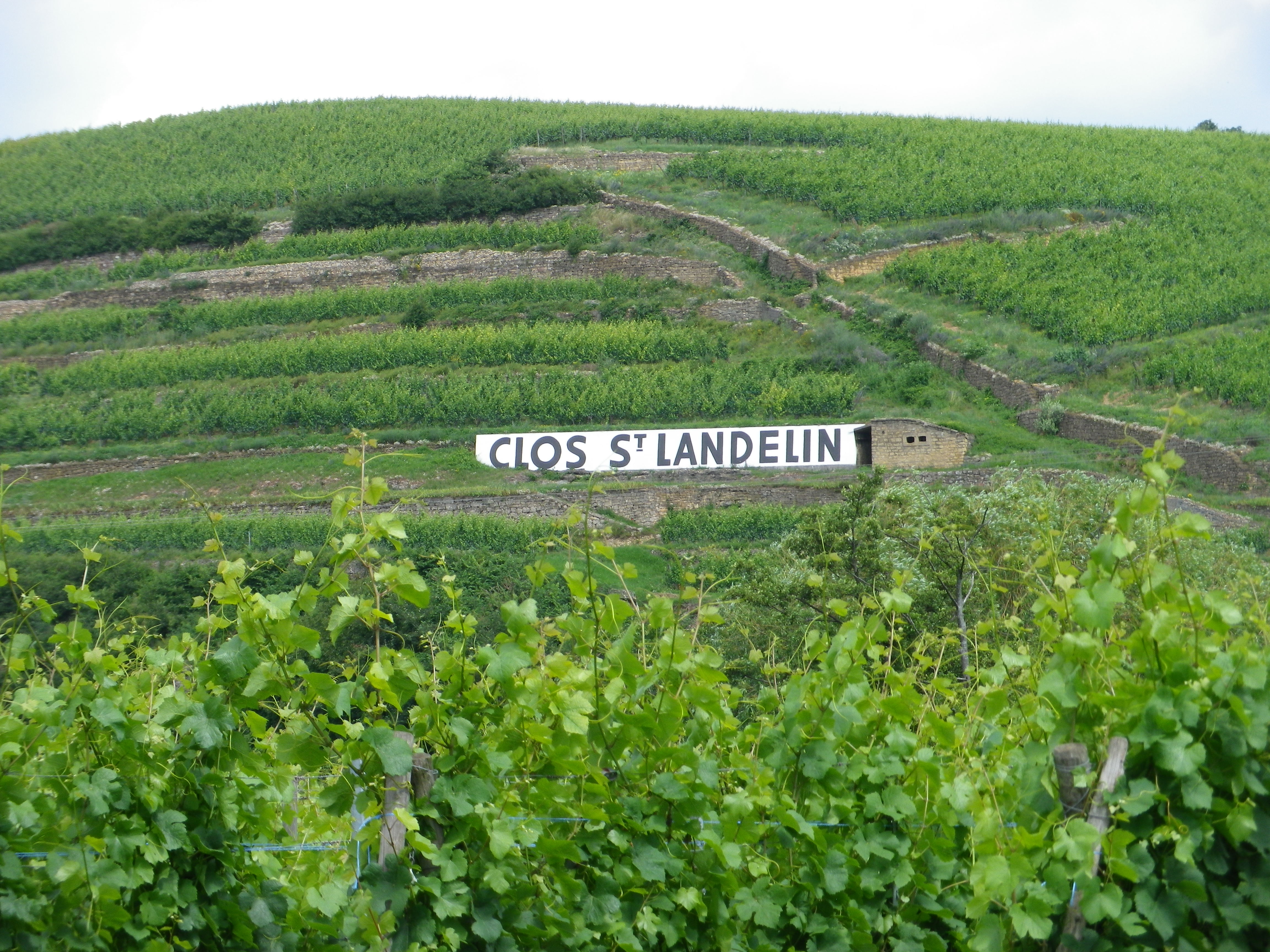
The reason for this is simple. Merovingian kings allotted early monks large territories in pagan areas to encourage conversion, as well as to grow vines (for communion wine). Both vines and conversion went from strength to strength, and soon Alsace was known for both. The circuit took me past both the former Abbey of Marbach, (over 1000 years old), and the nearby Hatschbourg Grand Cru. We have the monks to thank for the rebirth of wine -making in Alsace, and their descendants for doing such a great job of it.
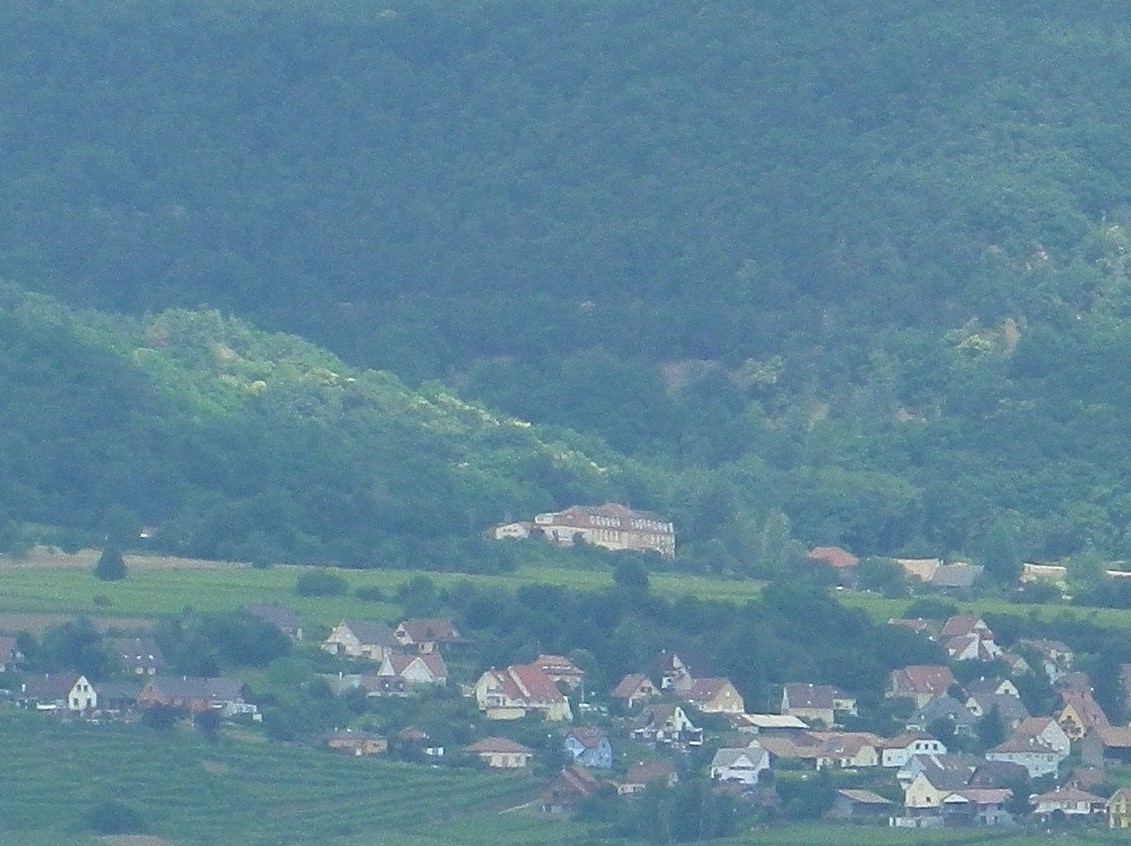
But the height of this match-up came in Eguisheim, at the end of the early Middle Ages. This village which still retains its medieval look, saw a local man, Bruno von Egisheim-Dagsburg, become Pope Leo IX. As son of a nobleman, I wondered, if as a child, he lived in one of the three castles high above the town. (To hike there, see the Nutshell here.) Neither the palace in the center of the village, nor the Chapel of St Leo IX, dates to his era. Nonetheless, the narrow, twisted alleyways, and colorful half-timbered cottages make this a very photogenic village to visit. (Conveniently, Eguisheim marks roughly the half-way point on the circuit, and is the site of a Wolfberger wine cellar – and I love their Cremant!)
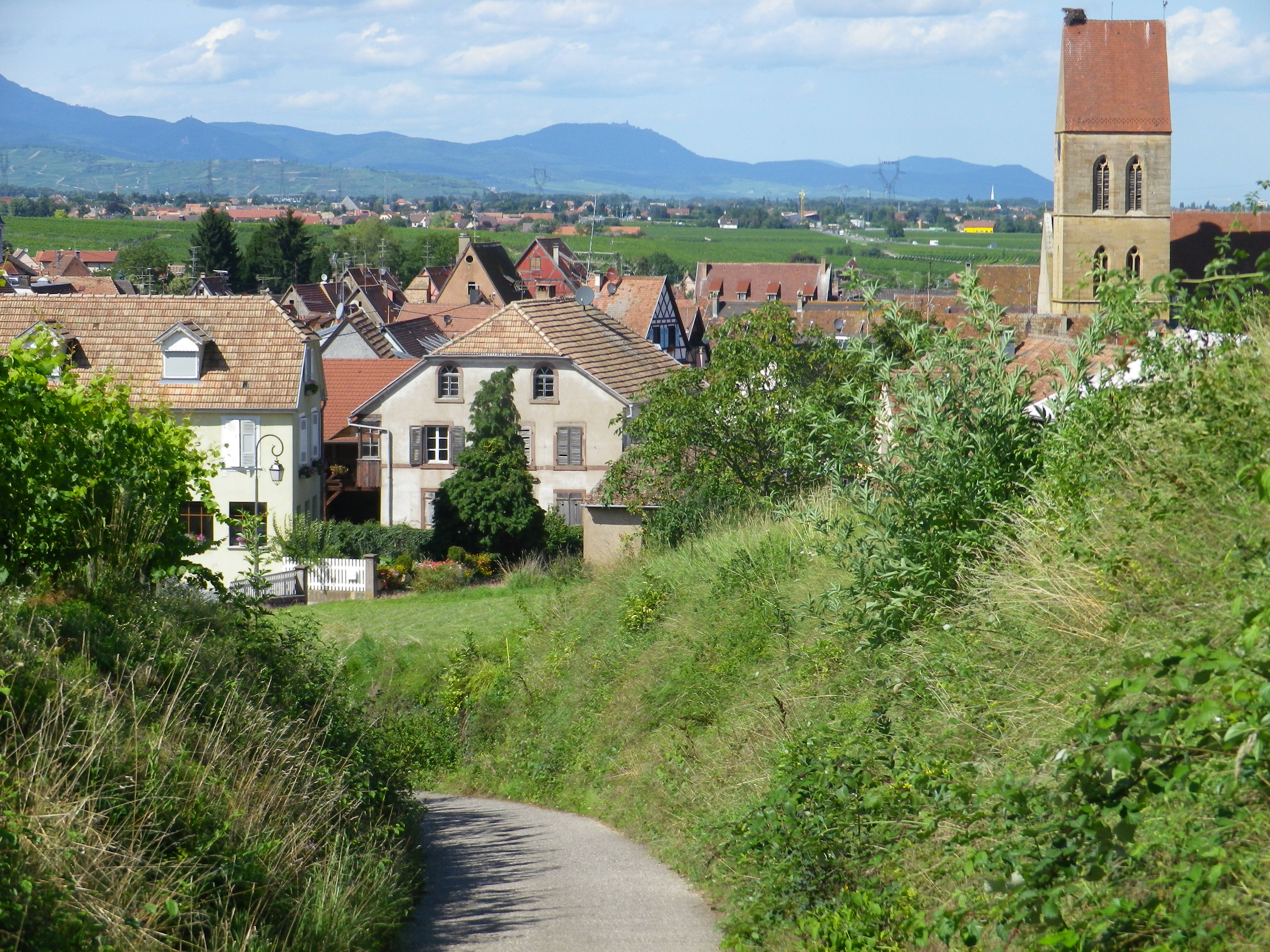
Leaving Eguisheim, up a short but rather steep path (maybe too much Cremant?), I found myself in the middle of the Eichberg Grand Cru. Monks owned this one too, at one point. Shortly after, I was cycling through the Hatschbourg then the Goldert Grands Crus, cruising into Gueberschwihr in no time. This attractive village is home to the Ernest Burn winery. The current owner, whose family’s wine-making tradition dates to 1620, showed me around, and offered more tastes of his Grand Cru Goldert and Clos St Imer wines than I was good for me, at that point. But they were distinctively perfumed and lovely to taste.
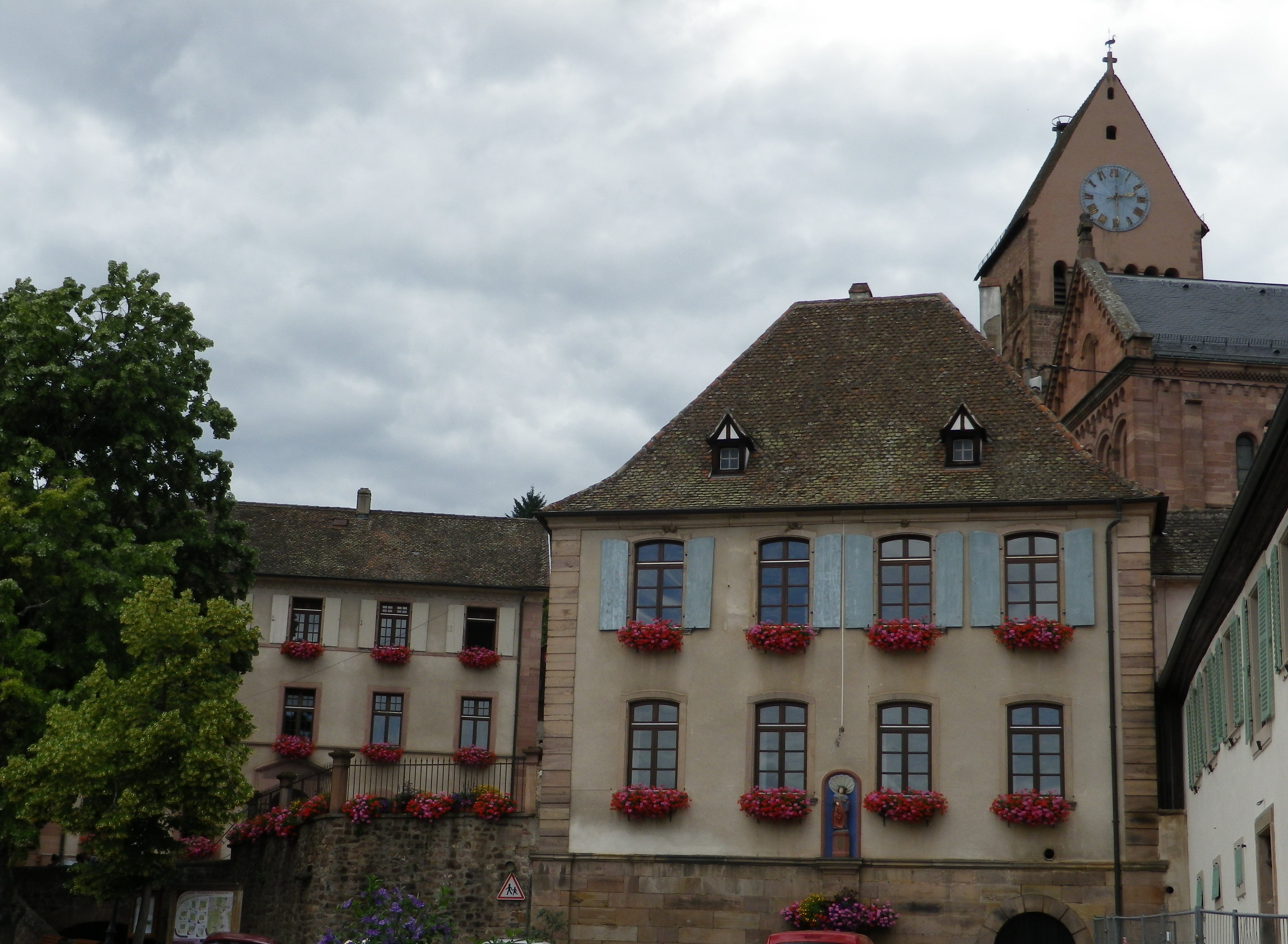
Fortunately, to return to Rouffach, there were only about five kilometers (3.25 miles) to go. With the beautiful weather and views, and having combined the best of both the cultural and viticultural worlds, I found this a really enjoyable, and quite memorable, half-day ride that I was sorry to finish.
Wine Notes: Haut Rhin Grands Crus
What I Learned:
Vorbourg, Hatschbourg, Goldert, Eichberg, Pfersigberg, and Zinnkoepfle are the special vineyard areas in the zone called the Champ de Fractures de Rouffach-Guebwiller, where millions of years ago, the land collapsed. This zone of the Alsace wine region is particularly known for its Grands Crus. The wines from Grands Crus are generally considered superior to non-Grand Cru wines because the terroir where they lie is considered particularly favorable for growing vines. Clos de St Landelin, Clos de St Imer lie within the Grand Cru Vorbourg and Goldert, respectively. The fact that these sub-sections of vineyards were enclosed indicates that grapes matured here especially well, and were tempting targets for thieves! Due to the particular nature of conditions here, certain grape varieties do very well in this zone. About 50 percent of the wines from these vineyards are Gewuerztraminer, followed by Riesling and Pinot Gris.
The Clos de St Landelin is a monopole (owned by one owner, in this case the Mure family), and sadly, I didn’t taste any of their wines. But I did taste a range of Ernest Burn winery’s Clos St Imer/Grand Cru Goldert wines. Burn offers wines with low acidity. They achieve this by delaying picking as long as possible (without becoming a vendage tardive, or late harvest, wine), then keeping one year in stainless steel tanks, followed by two years in wood barrels (not barriques). Due to this process, most Burn wines are older when first available for public sale (or tasting). It was a unique and delicious tasting experience, especially for the Riesling and Pinot Gris wines!
What I Tasted:
2012 Riesling, Alsace Grand Cru Eichberg, Appellation Alsace Grand Cru Controlee, Domaine Gruss (Eguisheim): A dry white wine with a dark light gold color; a nose with some vanilla and spice; notes of citrus, peach, and toast; medium acidity, well-balanced overall.
2012 Pinot Gris, Grand Cru Eichberg, Leon Baur (Eguisheim): A dry white wine with medium gold color, scent of fresh grass, with hints of honey and a trace of vanilla and spice; mild acidity
2010 Gewuerztraminer, Clos Saint Imer, Appellation Alsace Grand Cru Goldert Controlee, Domaine Ernest Burn (Gueberschwihr): An off-dry white wine, with medium gold color; an explosion of roses on the nose, and with rich exotic fruits, (lychee, ripe pineapple), spices, to include vanilla, flavors; very mild acidity, with a medium length finish.
2009 Riesling, Clos Saint Imer, Appellation Alsace Grand Cru Goldert Controlee, Domaine Ernest Burn: An off-dry white wine with light-plus gold color; turpentine nose, with rich fruity red apple and pear flavors; very, very mild acidity.
2009 Riesling, Clos Saint Imer, La Chapelle, Appellation Alsace Grand Cru Goldert Controlee, Domaine Ernest Burn: A dry white wine with medium minus gold color; nose of spice, and slight turpentine, flavors of peach, apricots, vanilla and a hint of floral; mild acidity.
2009 Pinot Gris, Clos Saint Imer, Appellation Alsace Grand Cru Goldert Controlee, Domaine Ernest Burn: An off-dry white wine, light gold in color with a slight trace of pink; ripe, white stone fruits nose; ripe peach, ripe melon and honey flavors; low acidity.
2009 Pinot Gris, La Chapelle, Goldert, Clos Saint Imer, Appellation Alsace Grand Cru Controlee, Domaine Ernest Burn: A dry white wine with dark gold color; exotic fruits nose, flavors of honey, ripe apricot, ripe honeydew melon, pineapple; mild acidity.
2007 Riesling, Clos Saint Imer, Appellation Alsace Grand Cru Goldert Controlee, Domaine Ernest Burn: An off-dry white wine with gold color; medium-plus gold color; turpentine nose, with rich fruity flavors and a trace of minerality; very, very mild acidity.
2007 Pinot Gris, Clos Saint Imer, Appellation Alsace Grand Cru Goldert Controlee, Domaine Ernest Burn: An off-dry white wine, light pink-gold in color; ripe, white stone fruits nose; ripe peach, ripe melon and honey flavors; low acidity.
Paysage a Bicyclette: Trail in a Nutshell
Trail Name: Paysage a Bicyclette
Trail Type: Mid-distance circuit biking trail; much of it paved and car-free, well maintained, fairly good signage throughout (but at least bring a map, if nothing else).
Length:
Total: 31 kilometers/ 19.5 miles
Convenient to: Colmar, Alsace, France
Marking:
White pointy-ends rectangular sign with dark letters: Paysage a Bicyclette in script writing
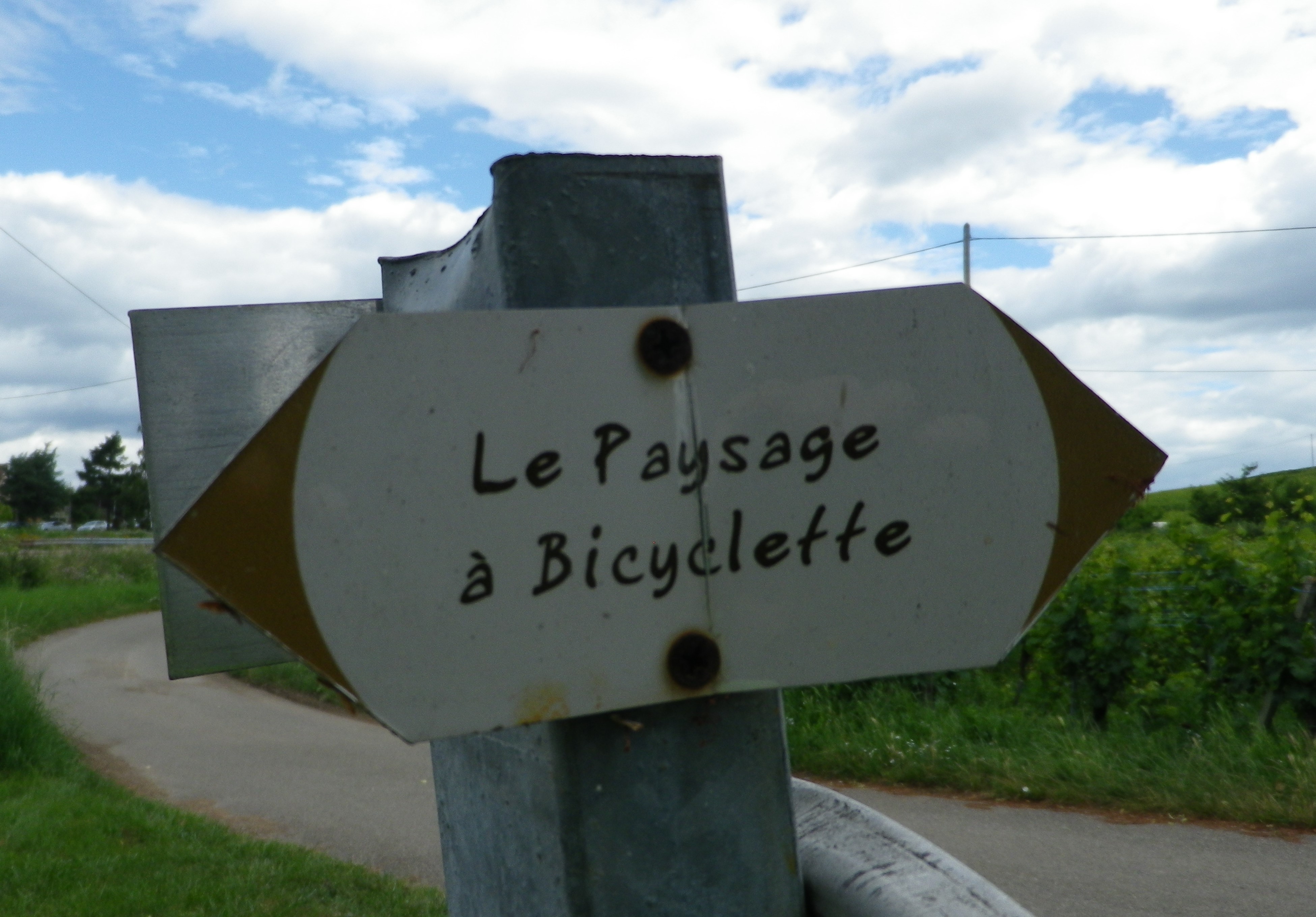
Trail Description: A slightly challenging trail through vines and villages in a relatively quiet section of the Alsatian wine region, offering plenty of opportunities to reconnect with nature, admire the wide expanses, and taste wine while exploring small towns and villages along the route!
Trailhead:
Official: Rouffach: Mairie (Town Hall), on Place de la Republique
Alternative: Eguisheim: Grande Rue
Parking:
Eguisheim: Grande Rue, large paved lot, reasonable fees
Rouffach: Place des Sports, large paved lot, with overflow parking nearby, free
Public Transportation Options:
Rail: SNCF regional trains (TER), regularly connect Rouffach (station less than one kilometer from the trail) with Colmar and Strasbourg to the north, and Mulhouse to the south
Suggested Stages:
Not applicable
Trail Itinerary-Reference Points:
Rouffach: R du Marechal Joffre/D18Bis-R Claude Ignace Callinet, R. Louis Pasteur-R. des Vosges-Route de Westhalten; Cross Muehlweg, onto track named Saegmattenweg; Gundolsheim: D15/Route de Rouffach-R. du Nord-Schlittweg-Gundolsheimerweg; onto Holderhuerstleweg, over train tracks, hard right but continue on trail, Rouffach: cross D8, Heiligkreuzweg-Staaweg; cross tracks, then parallel them on Gaertleweg; Metzgermatten and Kiffmatten fields; woods, cross D83 highway; Hattstatt: D121/Route du Vin; Alte Staatstrasse, Herrenstr trail, Rte de Herrlisheim/D1bis; Eguisheim: D14/Grande Rue, R. du Muscat-R du Vin, unnamed trail to left after R. du Buhl; Obermorschwihr: Dagsbourg Hohlweg, R du Dagsbourg-R des Pres; fields and vineyards; Gueberschwihr: R du Nord, R Basse-Route de Pfaffenheim; Gaensbrunnweg trail, then first right; Pfaffenheim: R du Muscat, Grande Rue-Drotfeldweg-Kopfacherweg; Alte Strasse through vineyards-R. Louis Pasteur
Representative Trail Photos:
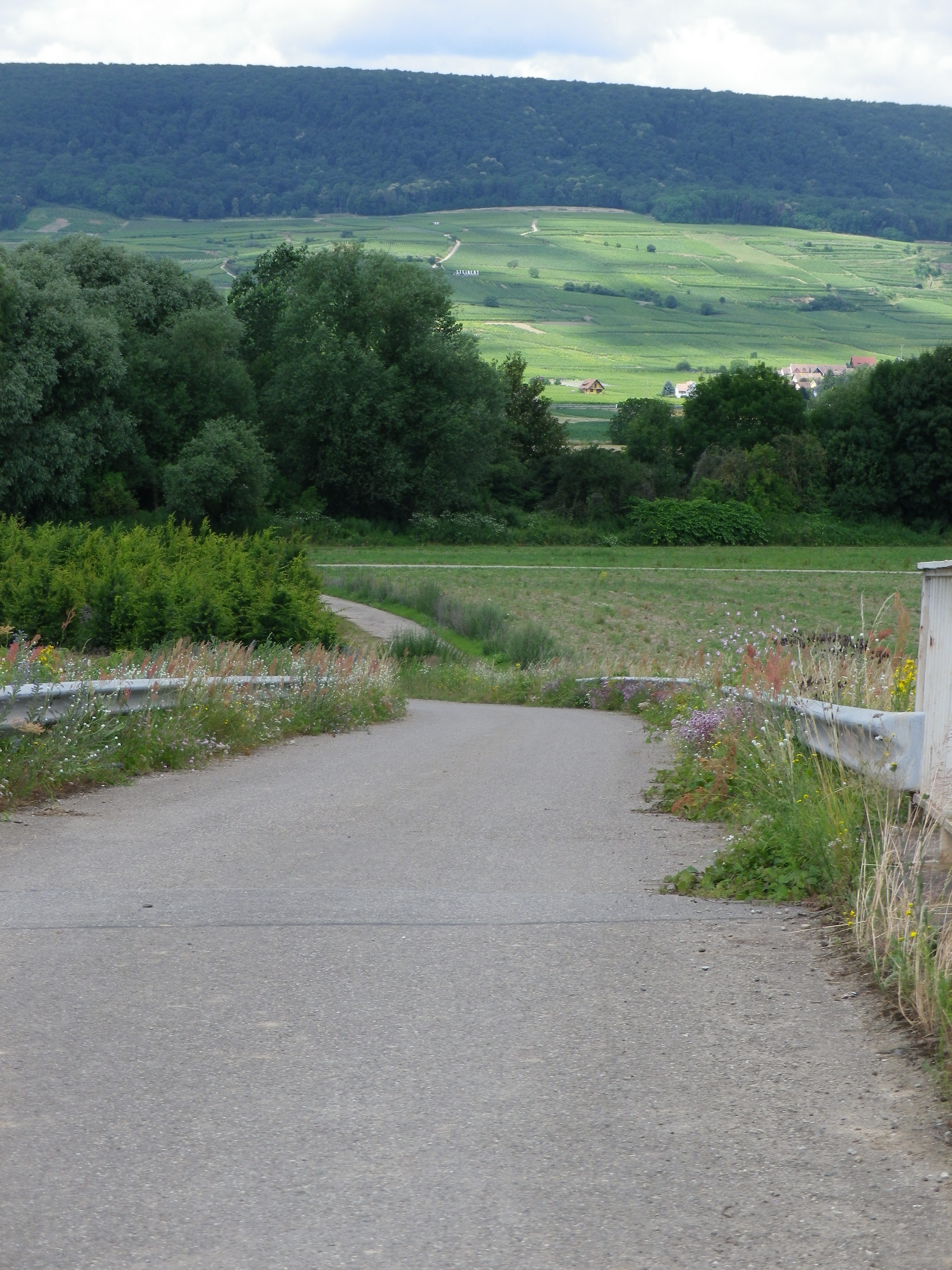
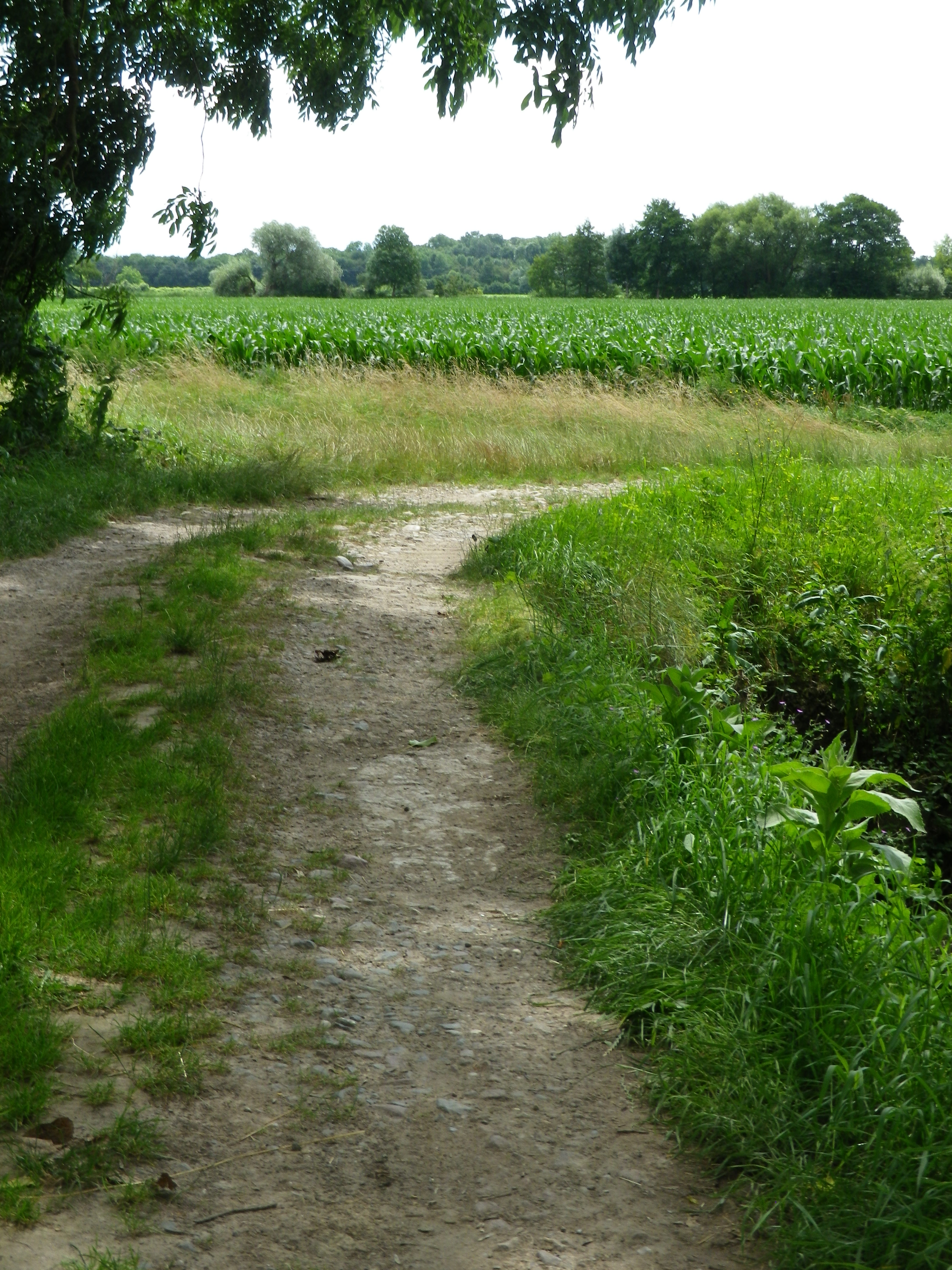
Restrooms:
Rouffach: R. du 4eme Spahis Marocains (by the bus stop)
Eguisheim: by the paid parking lot (see parking above), and in the old center in Cr Unterlinden
Attractions on or near Trail:
Eguisheim:
The Little Train will take passengers through vineyards as well as the town
The Wolfberger Cave has a discovery room with some explanations and photos, in addition to a large boutique for lots of its wine and wine-related products.
Tasting along the Trail:
Wineries, mostly family-owned, in every village – you will be spoiled for choice. Do not hesitate to visit one (or several) between roughly 9-1200, and 14-1800 on most days (some including Sunday mornings during tourism season)!
Alternative Options:
Hiking:
Eguisheim: Vignoble et Chateaux, a short but steep in places trail that passes through a great variety of scenery and terrain, with great views. See the Nutshell here.
Soultzmatt or Westhalten: https://www.visorando.com/randonnee-promenade-dans-le-vignoble-de-la-vallee-/ thru vineyards, listed as medium difficulty (hills, not much shade)
Additional Information:
Trail (segment) specific: https://www.cirkwi.com/fr/circuit/536654-le-paysage-a-bicyclette
Comments:
A fantastic area for wines, history, and hiking and biking in nature.
Gallery March 2023
Grand Grapes and Castles
Selestat, an important town for centuries throughout the Middle Ages, has numerous attractions for visitors, both viticultural and historical. The Velo Route du Vignoble d’Alsace (the Alsace Vineyard Bike Trail) first brought me here. (See the Nutshell). The trail’s northern half is somewhat hilly. So, by the time I got to the villages in the foothills just outside Selestat, between Dambach-la-Ville’s Grand Cru Frankstein vineyard and Kintzheim’s Grand Cru Praelatenberg vineyard, I was delighted with the flat stretch through vineyards overlooked by castle-topped mountains. I decided then to return to hike the area someday.
After years of remodeling, Selestat’s Bibliotheque Humaniste (Humanist Library) finally reopened, and I began researching local wine-themed trails. I first found the Vignoble de Selestat trail. (Online, the Circuit de Piemont and the Circuit du Vignoble refer to the same itinerary.) So, after visiting the library in the morning to see Merovingian and Carolingian manuscripts, I headed a mile away to the trailhead in Chatenois.
